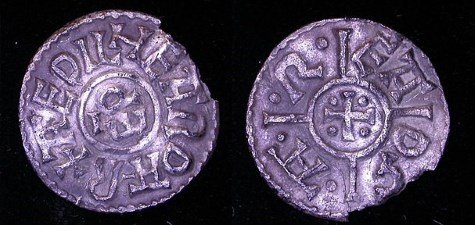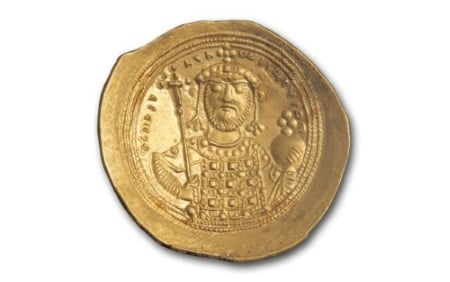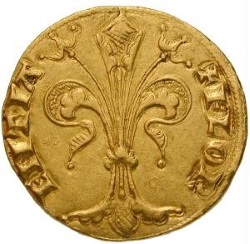E.L. Skip Knox recently published a great post on one of my favorite resources, Mythic Scribes, titled, History for Fantasy Writers: Money. Knox is the creator of the fantasy world called Altearth, a place where magic is real, monsters roam the land, and the Roman Empire never fell. He is also a retired medieval historian who is now engaged in deconstructing the Middle Ages into a fantasy setting, so he’s the perfect person to offer a brief description of currency through the ages.
Medieval money can be divided into two distinctly different types: the kind that existed and the kind that didn’t. Real money was currency, specifically coins of various qualities and weights. The other kind was called “money of account.” This was purely an accounting unit, used for large-scale transactions and never turned into a physical object. I’m sharing here Knox’s information on the former; you can read his post for the rest.
Currency

8th Century silver penny. Image: Mythic Scribes
When you read about a silver mark in the Middle Ages, do not picture a coin. No such coin existed before modern times. By far the most common coin throughout the Middle Ages was the silver penny, known in Latin as the denarius. The word was preserved in the Romance languages as the denier in French, the dinero in Spanish, denari in Italian, and denar in Hungarian. The Germanic languages had their own term: pfennige in German, penningen in Dutch, and pence or penny in English. The coin was typically quite small. Now that you know the term and the coin, you understand why pence in English is abbreviated with a lower-case d, as in: £5 3s 5d. The “s” is for shillings.
All this was silver. No gold coins were struck in the West since the fall of the Roman Empire. Gold coins were in circulation, of course, but the West simply made use of existing coins as well as new coins from Byzantium (the bezant) or Islam. Silver was sufficient, along with money of account for large transactions.In the 13th century a larger coin came into existence, known in English as a groat (groschen, gros, gros tournois). The word simply means big and the coin was colloquially known as the “big penny.” It was typically worth four pennies.

The first gold coins were struck in Florence in 1252 and were called florins. Gold coins had also been occasionally struck as commemorative pieces for big events, but this was the first that was intended as currency. By our period, there were three types of coins: gold, silver, and debased coin also called “billon”.

The English gold coin was the noble, whose value was fixed at 1/3 of a pound and which was first struck by Henry VII in the 1480s. The French gold coin was the franc. In the Rhineland, it was a gulden. In Venice, it was the ducat. In general, the florin was the most widely used standard. It was gradually superseded in the 15th century by the ducat (first issued in 1284).
Debasement and Cutting
Silver coins were steadily debased all through our period, in some cases to the point where they had only 1/96th of their 13thc silver content. Copper was mixed into the coin to such an extent that this debased coinage was known as “black money” (another term you may see is “billon”). Only the English penny stayed fine silver. Groschen generally fared better. Where there was more silver than copper, it was known as “white money”. For example, the groschen of the Rhineland were called “white pennies” (Weisspfennigen).
Money was also debased through the process of clipping. As you might guess from the images you’ve seen so far, it was possible with some coins to trim away the edges. Do this with enough coins and you have enough silver to turn a nice profit while still passing the original coins at their original value. This was strictly illegal and getting caught meant mutilation or even execution. This is also why coins came to have burrs around the edge, making clipping more obvious.
What Was Money Worth?
This question gets asked all the time. How much was a groschen worth? A shilling? There’s no consistent answer across time and space. You might just as well ask how many sheep it costs to buy a horse. It would depend on buyer and seller and the circumstances. Prices were generally pretty fluid in the Middle Ages.
Not that people didn’t try. Kings and dukes and such-like were forever issuing decrees that stated a royal franc must contain this many grains of gold and be of this weight, worth this many deniers. You can readily find tables giving ratios. In practice, it came down to what the moneychanger would give you, and that depended heavily on where you were (it was easier to bend the law in Auvergne, say, than in Paris) and even who you were.
For the Fantasy Writer
All this comes down to a comforting conclusion for the author: you can pretty much make up whatever you please. Just don’t make the price of a horse the same as the price of a mug of ale. Unless it’s really special ale.
An author might consider making a bit of use of clipping. It was done all the time. No need to make a big deal of it, but if you have a band of ne’er-do-wells, someone in the group ought to be able to shave off a bit of profit. ahem If you want to go further, counterfeiting is a possibility, though it was extremely risky and required equipment.
A good place for a robbery would be a mint. Better than a bank, really. The target would not so much be actual coins as grabbing the raw silver. Has anyone knocked over a mint in a fantasy novel?
Another opportunity lies in the variety of currency. Your hick hero has a few coins and is baffled to find no one in the big city will take them. He has to hunt up a moneychanger, and finds himself poorer than he realized. Or he’s taken advantage of, and a new character comes to his defense, forming a friendship.
And a final possibility. What about magical coins? Maybe your world has actual currency specific to magicians. Or a wizard uses magic to conjure up coins that look real, until he leaves town. What would be the safeguards against such fraud? Forget fireballs and demon conjuring. Just let me spin up coins whenever I want them!
If you enjoyed this excerpt, read History for Fantasy Writers: Money on Mythic Scribes. And for more information about money today explore the difference between Bitcoin and real money.
What’s Next?
So many people talk about bitcoin nowadays that I just had to include this hilarious video “explaining” bitcoin:





A fascinating post, Nicholas.
Thank you, Michelle 😀
Thanks for this thorough and interesting post, Nicholas. 🙂 — Suzanne
Thanks for reading! I’m glad you enjoyed it 🙂
It’s interesting to read about how currency has changed over the years. The video is a riot too…They remind me of Monty Python. LOL.
Totally Monty Pythons 😀
This is fascinating stuff! And I don’t even write historical fiction! thanks a ton, Fun article.
Thanks! Neither do I. I found it super-helpful for my fantasy, though. Getting the details right can make all the difference between a great book and a meh one.
When I was young, (in the 1950s) old people still referred to two shillings as a ‘florin’. There was a two-shilling coin, until 1967. They would also multiply it, to refer to an amount, as in ‘Three florins’ for six shillings.
Best wishes,Pete.
Lol-you’re just dating yourself now 😉
I never worry about doing that, Nicholas. I grew up at a great time. The 1960s! 🙂